This post may contain affiliate links, from which we earn an income. Click here to read our affiliate policy.
Monte Cassino Abbey, perched on a hill in Italy’s Lazio region, is not just a historic monastery; it’s a site deeply intertwined with the brutal realities of World War II. If you visit central Italy, the beautiful and historic sites of Monte Cassino and the War Graves Cemeteries are a must.
The Abbey of Monte Cassino and its surrounding battlefields and memorials serve as a powerful reminder of the cost of war and the resilience of peace.
In this Monte Cassino guide, we explore the history and significance of this site and share everything you need to know about visiting including getting there, the best organized tour options, and recommendations for places to stay plus a few insider tips for your visit.
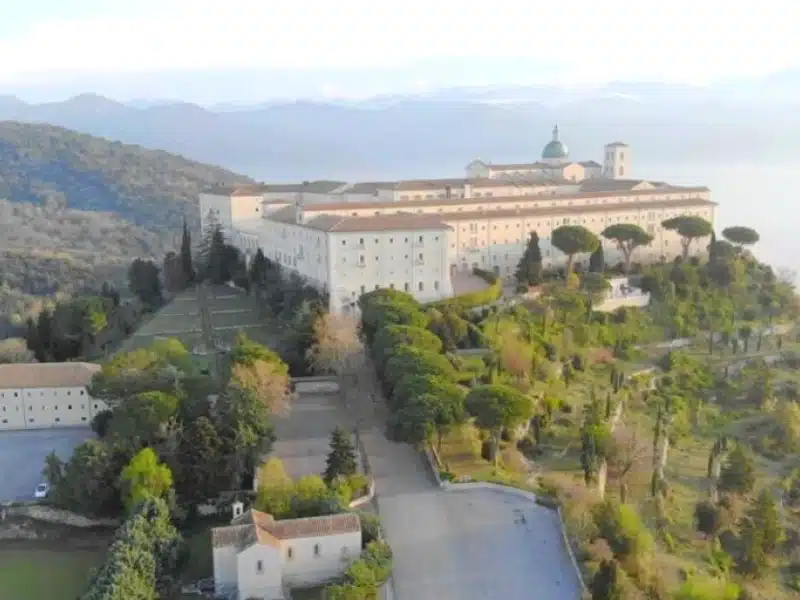
Monte Cassino History
Monte Cassino (sometimes called Montecassino) is a 6th century historic abbey with a rich and multifaceted history that spans over 1,500 years. Founded in 529 AD by St. Benedict of Nursia, it is renowned as the birthplace of the Benedictine Order, which played a crucial role in the spread of Christianity and learning throughout medieval Europe.
The abbey’s strategic location on a rocky hilltop in the Aurunci Mountains has made it a focal point of numerous conflicts, but none so devastating as during World War II.
Early History
The Abbey of Monte Cassino was established by St. Benedict himself, who chose this secluded hilltop as the site to build a monastery dedicated to St. Martin of Tours.
Over the centuries, the abbey became a center of religion, education, and culture, amassing a vast collection of manuscripts and playing a vital role in preserving Roman and Christian texts during the turbulent Middle Ages.
The abbey was destroyed and rebuilt several times due to wars, earthquakes, and sackings, but always rose again, each time more magnificent.
After the dissolution of the Italian monasteries in 1866, Monte Cassino became a national monument and remains one of Europe’s most important religious buildings.
World War II and the Battle of Monte Cassino
The abbey’s most tragic moment in history came during World War II, specifically in 1944, during the Battle of Monte Cassino, also known as the Battle of Rome. This series of four tough battles between the Allies and Axis of the Third Reich forces aimed to break through the Winter Line and seize Rome from the south.
The Allied forces believed that German troops were using the abbey as a lookout post and artillery observation post, although there is evidence to suggest that the Germans occupied the ruins only after the Allies’ bombing.
On February 15, 1944, in an effort to eliminate any potential German advantage, the Allies bombed Monte Cassino Abbey, reducing much of it to rubble. The destruction of the abbey did not achieve the strategic advantage the Allies had hoped for; it actually provided the German Army with better defensive positions among the ruins.
The battles that followed were fierce and costly, with heavy losses and tens of thousands of lives lost on both sides.
It wasn’t until May 1944, after months of intense fighting and heavy casualties, that the Allied forces finally succeeded in breaking through the German military defenses, leading to the liberation of Rome. The Abbey of Monte Cassino lay in ruins, a poignant symbol of the war’s devastation.
Post-War Reconstruction and Legacy
After the war, the abbey underwent a painstaking reconstruction, largely funded by the Italian government and donations from around the world. It was rebuilt according to the original plans, using the same materials as much as possible.
The reconstruction was completed in 1964, and the abbey was reconsecrated by Pope Paul VI. Today, it is a place of worship and study and a monument to peace and resilience in the face of destruction.
The war graves near Monte Cassino are a somber reminder of the human cost of the battle. These cemeteries are meticulously maintained as a tribute to those who fell, ensuring that the lessons of the past are not forgotten.
Monte Cassino’s history is a complex tapestry of faith, learning, war, and rebirth and its legacy serves as a testament to the enduring human spirit in the face of adversity. When you visit the abbey and its war graves you will undoubtedly be moved by the profound sense of history and the palpable reminder of the costs of conflict.
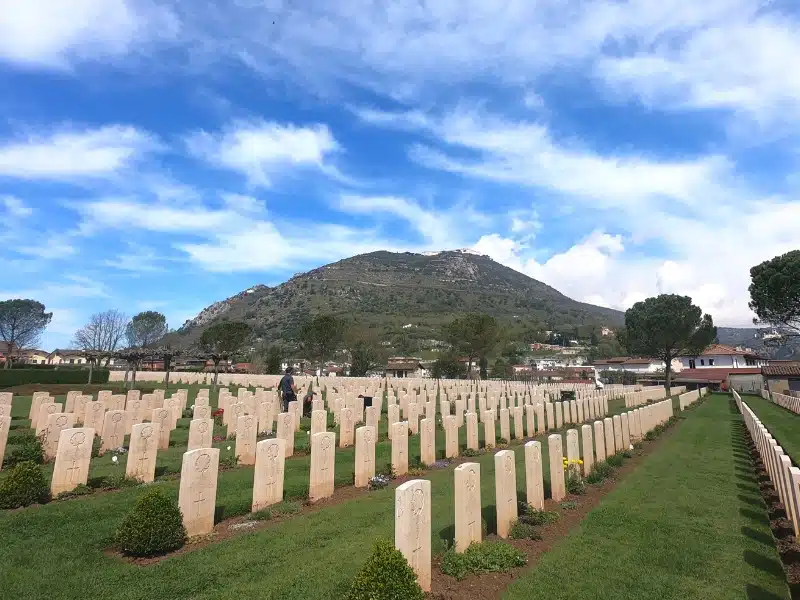
Is this your first time visiting Italy? Get all the information you need in our Italy Travel Guide, including what to pack, the best time of year to go, getting there and practical tips to help you have the best trip!
How to get to Monte Cassino
Car
Getting to Monte Cassino Abbey is simple. The town, in the province of Frosinone, is just a few kilometers off the main A1 autostrada from Rome to Naples.
From the town of Cassino itself, follow the signs for Monte Cassino which are plentiful as you enter the town. The windy road up is wide enough for two large vehicles to pass, including buses, something of a rarity on rural Italian hillsides!
The Commonwealth War Cemetery of Cassino is to the south of town on the SP76.
Public Transport
If you don’t have a car you can get to Monte Cassino using trains and a bus. Catch the direct train from Rome to Cassino and at the train station you’ll find the MC006 bus for the abbey that leaves daily at 9.55am, 11.30pm, and 3pm, and returns to the train station at 10.15am, 12.50pm, and 4.55pm.
Use the Trenitalia website to plan your journey and book your tickets. From Rome, use the station ‘Roma Termini’ and make sure to enter ‘Cassino Abbey’ or ‘Cassino Abbazia’ to get tickets which cover the whole journey.
Organized Tours
A great way to see more of Italy in less time, these organized tours provide transport and a guide. Here is our pick of the best organized tours to both abbey and battlefields:
Make sure you have travel insurance you can trust when visiting Italy. We recommend True Traveller for their 5-star TrustPilot reviews, variety of cover options, best activities cover as standard, great prices, and excellent service.
Where to Stay in Monte Cassino
Good mid-range hotels in or just outside Cassino include the Best Western Hotel Rocca, a private apartment Bilocale nel centro di Cassino and the Kairos Resort and Spa which makes a nice spot for a few days stay.
Budget options include the lovely Agriturismo il Pioppeto and the Hotel Piazza Marconi, right in the middle of town.
If you are traveling around Italy in a motorhome or campervan, you can spend the night in the Monte Cassino Abbey car park, for a small fee. There are no services at this site, so you need to be self-contained.
Wherever you decide to stay, try and get to the abbey early. The early morning views are spectacular and you’ll see the abbey in tranquility before the orders of coach trippers arrive mid-morning.
RELATED POST: The Ultimate Bucket List Italy Road Trip
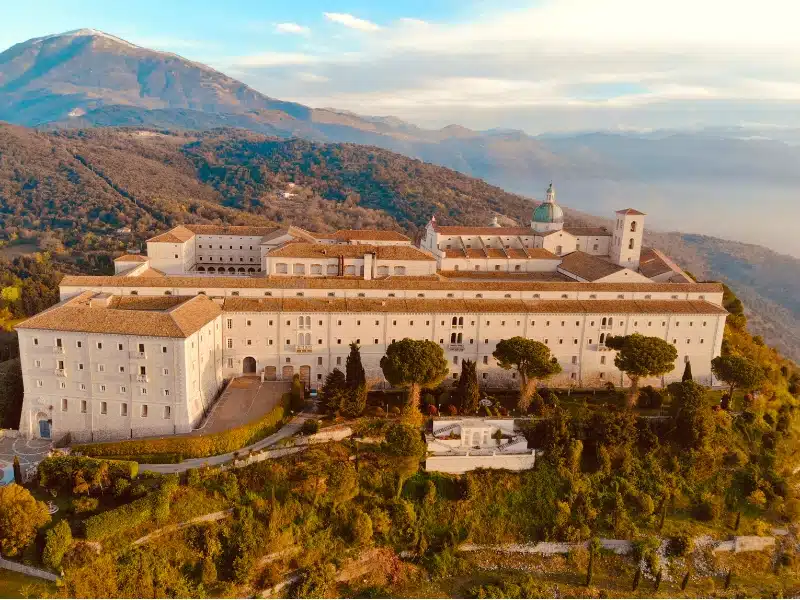
How to Visit Monte Cassino Abbey
The views from outside the abbey are exceptional, with the Latin Valley leading towards the magnificent snow-capped Abruzzo mountains. In the morning sun, with the clouds hanging lower than the nearest peaks, the travertine of the abbey glows cream and gold in an archetypal Italian landscape.
The Abbazia di Montecassino is free to enter. Once inside, you quickly understand why this place was chosen for the worship of God.
As you stand at the central balcony looking out towards the mountains, you feel as though you are on top of the world, with all of Italy spread in front of you. The first Benedictine monks must have felt that they were next to heaven and could commune with God directly.
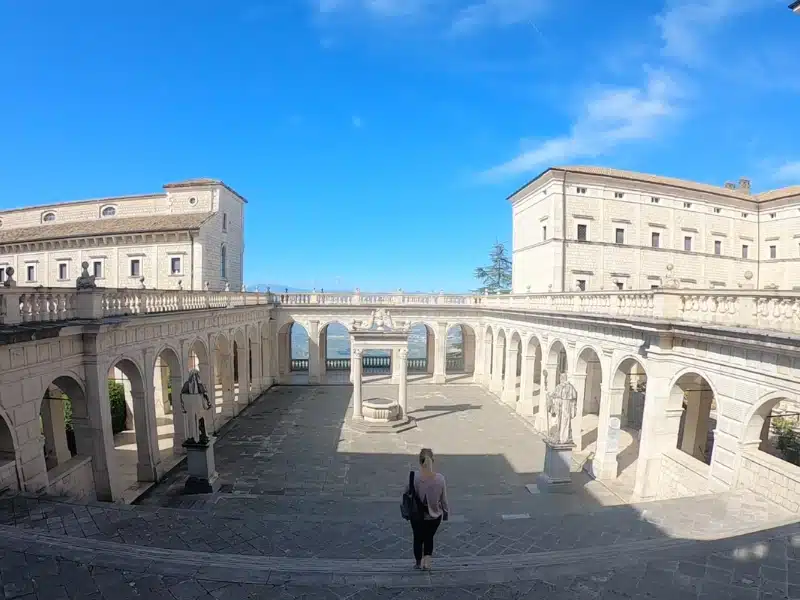
The basilica is breathtaking, every surface is covered with inlaid marble, mosaic tiles, frescoes, and carvings dedicated to the glory of God. The crypt is entirely covered in tiny mosaic tiles, with the entrance tunnel being wrapped in navy blue inset with golden stars to represent the night sky.
It is said that the remains of Saint Benedict, who founded the abbey, and his twin sister Saint Scholastica are kept in a bronze urn under the basilica’s high altar. It is also said that a crypt in the eastern portion of the church contains the tomb of St. Benedict. It may also be possible that the relics of Saint Benedict and Saint Scholastica were moved in the seventh century to Saint-Benoît-sur-Loire in Northern France!
It is easy to imagine monks at worship here; the windows in the basilica are designed and arranged to allow the light to penetrate the darkest corners, which creates a spiritual and calm atmosphere.
We left feeling overawed by the scale and beauty of the building and the determination and resilience of its builders and dwellers over the centuries.
Guided group tours to a small bit of the original abbey that was not destroyed in the war take place daily in English. Reservations are highly recommended and can be made by email via the abbey’s official website.
Monte Cassino Abbey Opening Times
It is not possible to visit the church during Mass, which is held every Sunday 10.30am and 12 noon.
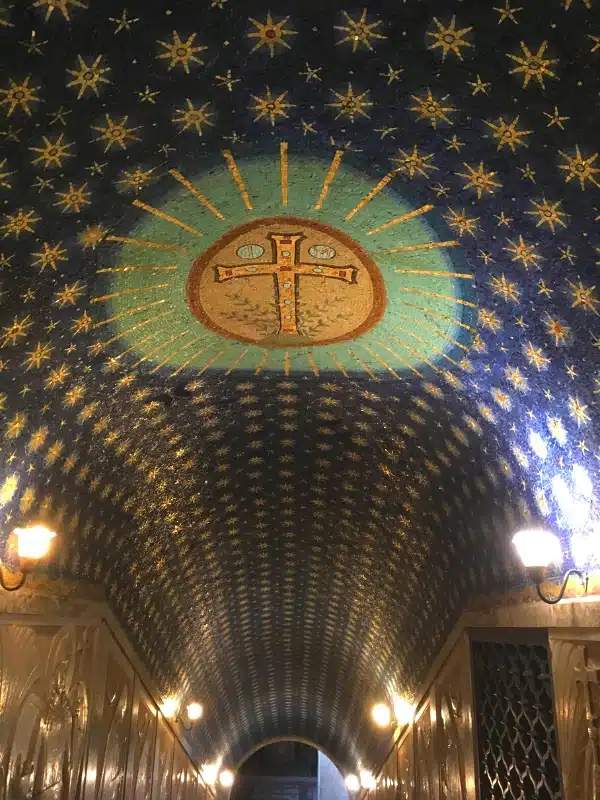
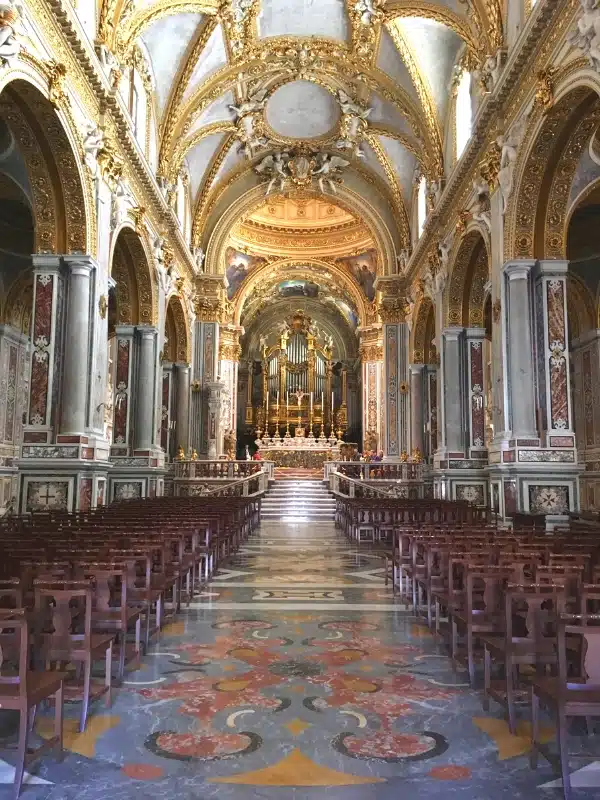
How to Visit Monte Cassino War Cemeteries
There are three war cemeteries at Monte Cassino; the Commonwealth War Graves Cemetery which is located to the south of the town, and has a poignant view across to the abbey and its rocky hillside, and the Polish World War II Cemetery which is on the same hillside at the abbey and the German War Cemetery in nearby Caira.
Monte Cassino Commonwealth War Graves Cemetery
Signage to the Commonwealth Cemetery is regular and clear and there is enough parking for a few buses and a dozen or so cars.
The cemetery is beautiful and moving, laid out with military precision and organization, as all Commonwealth war cemeteries are. Soldiers from the United Kingdom, the United States of America, France, Australia, New Zealand, India, Canada, South Africa, and Russia are buried and remembered here.
All the headstones are a uniform size and stretch through the grassy field in rows of white polished stone. Many of the graves had tulips and wildflowers planted by the headstones which brings welcome relief to the rigid rows.
Each headstone commemorates the individual with their cap badge, rank, name, and date of death. On far too many headstones the inscription is simple ‘an Unknown Soldier of WWII’.
We found these graves the hardest to bear; a young man lying forever in a foreign field nameless and unidentified yet living on forever in the DNA of his ancestors, during every poignant last post played and in every poppy proudly worn.
The wide and low Stone of Remembrance is set in the grass in front of the entrance building and engraved with the words ‘their name liveth for evermore’.
The Cassino Memorial is located around an ornamental garden with tall pillars and a water feature. Stone steps lead to the water feature as well as to the pillars, and The Cross of Sacrifice is on the far side of the central water feature, towards the rear of the cemetery.
Cassino War Cemetery Opening Times
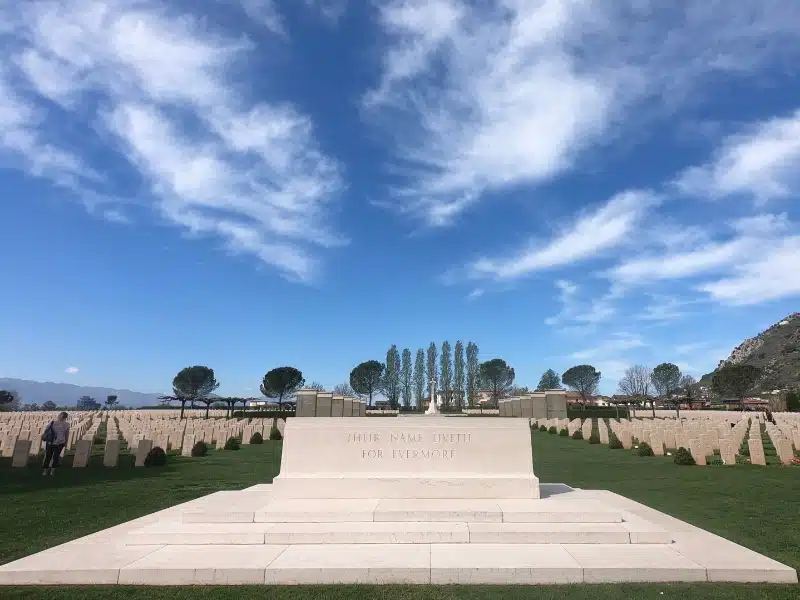
Monte Cassino Polish World War II Cemetery
The Monte Cassino Polish War Cemetery is a place of quiet reflection, characterized by its orderly and respectful presentation.
A short walk fifteen minute walk from the abbey, the cemetery is close to the Memorial Museum of the 2nd Polish Corps at Monte Cassino. The Polish cemetery is the closest of the allied cemeteries in Monte Cassino, an honor given to the Polish troops as their units are the ones credited with the liberation of the abbey from German forces.
Upon entering the cemetery, you are greeted by rows of graves, each marked by uniform crosses that denote the final resting places of 1,072 Polish soldiers.
The layout of the cemetery and the simplicity of the white marble crosses, each inscribed with a soldier’s name, rank, and unit, provide a solemn and contemplative atmosphere.
At the heart of the cemetery stands a prominent memorial, engraved with inscriptions that pay tribute to the bravery and sacrifice of the Polish soldiers. This central monument is a focal point for remembrance and reflection and is incredibly moving.
It’s hard to imagine the horrors of war in this beautiful and dignified cemetery, but remember them we must.
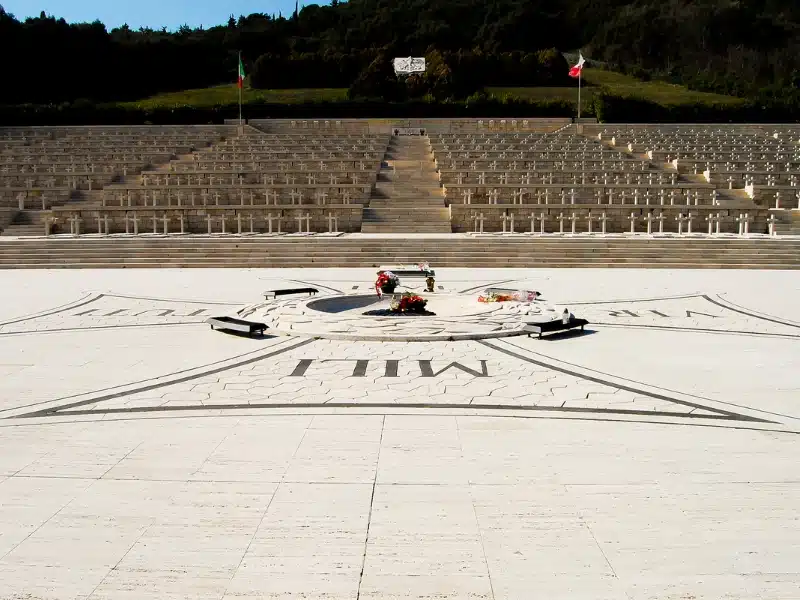
German War Cemetery Cassino
The German War Cemetery in Cassino is located a few kilometers north of Cassino, in the village of Caira, and spans an entire hill. This site is the final resting place for 20,027 German soldiers who lost their lives in Southern Italy, except Sicily.
Many of these soldiers perished during the Battle of Salerno, after the Allied invasions there, as well as in the Adriatic region of the Apennines, during the Battle of Ortona, and in the many battles around Monte Cassino.
The construction of the cemetery began in 1959, following the reinterment of soldiers from various burial sites, and was completed in 1964. At the entrance, a statue representing a man and woman in mourning symbolizes the grief of the families who lost their young loved ones.
The cemetery layout includes seven terraces, connected by pathways, with a bronze cross standing atop the hill Additional graves, including those of unknown soldiers, are situated behind it.
This cemetery is as moving and thought-provoking as the others and from the hill’s summit, there are sweeping views of the Cassino battlegrounds.
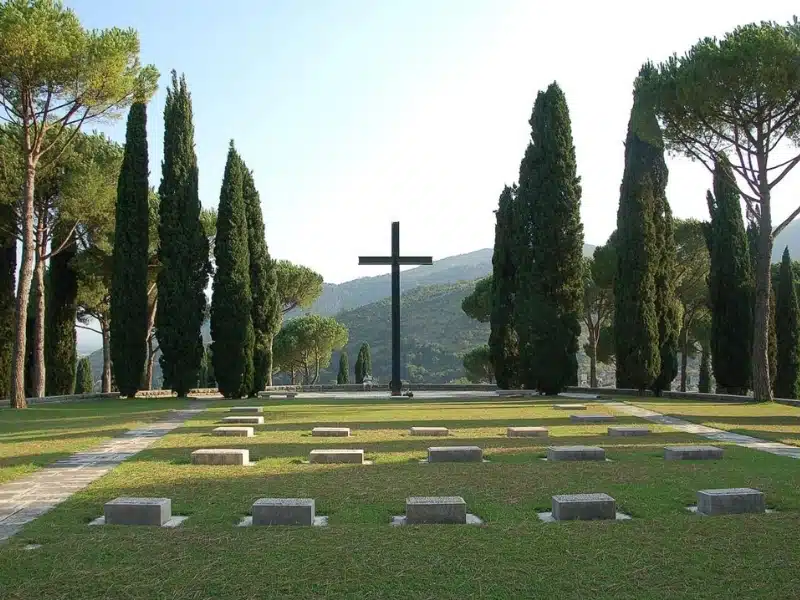
Other Monte Cassino Landmarks
On the same rocky hill as the Polish War Cemetery on the Albaneta Estate are several other Second World War places of interest to visit.
There is a marked walking trail between the Polish cemetery and memorials and you’ll see signs and information points along the trail. You’ll need sturdy shoes if you want to walk from the town or the abbey as the terrain is rocky.
As well as the memorials you’ll also come across the ruins of the Monastero Santa Maria dell’Albaneta and the abbey’s brewery, which produces La Birra d’Abbazia and local honey. There is a delightful garden where you can sit and enjoy this most local of lagers after your hike.
If you intend to spend a few days in the area, the following day could be spent exploring nearby Sant’Angelo In Theodice, the battlefield of the Rapido River, and the Freedom Bell memorial.
About 40 minutes by car to the east is San Pietro Infine, which was completely destroyed in late 1943 by fighting between the advancing U.S. forces seeking to break the Winter Line. The Parco della Memoria Storica, or History Memorial Park, contains the ruins of the village, lying as they were at the end of the war.
The Gate of Rome
The Gate of Rome sits just down the hill from the cemetery, known as Hill 593. A vantage point of the German 10th Army, the Gate was where the Germans had thwarted the Allied advance and their plans to break the Nazi forces’ Gustav line and head north.
But on the 18th May 1944, the II Polish Corps smashed through the German defenses on Hill 593 and paved the way for victory against the Germans in the Italian campaign.
On 2nd July 1944, General Bronisław Duch, the commander of the 3rd Carpathian Rifle Division, gave the order to build a monument to honor and commemorate the men who died fighting at the Gate. The text of the order reads “It is necessary that on quota 593, where the most blood was shed by the soldiers, there is a monument worthy of their glory as fighters”.
Today the spot is marked by a travertine obelisk topped by a cross. In front of the obelisk is a large white marble plaque engraved with the names of the Carpathian riflemen who fell in the battles for Monte Cassino between 1943 and 1945.
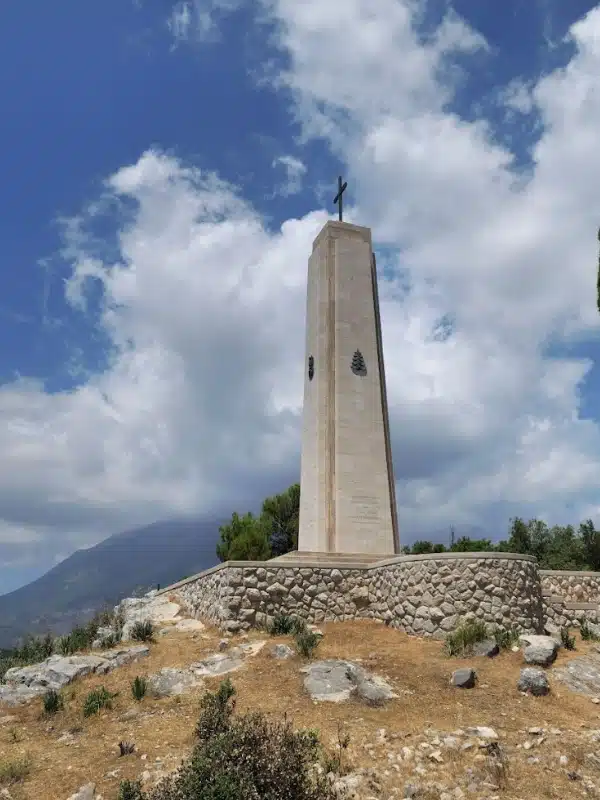
Polish Tank Memorial
Further still at the foot of Hill 593 are the remains of a Sherman tank used by the Polish Army. Caught between the northern slope of the Snakehead Ridge and the southern edge of the Phantom Ridge, a strong explosion hit the armored vehicle and caused the explosion of ammunition inside the vehicle.
The tank has been left where it last turned its tracks, the now has a sturdy cross coming out of the top opening. The entire crew from the Skorpion Armored Regiment were killed in the explosion, and there are often commemorative flowers or a Polish flag left on the tank in their honor.
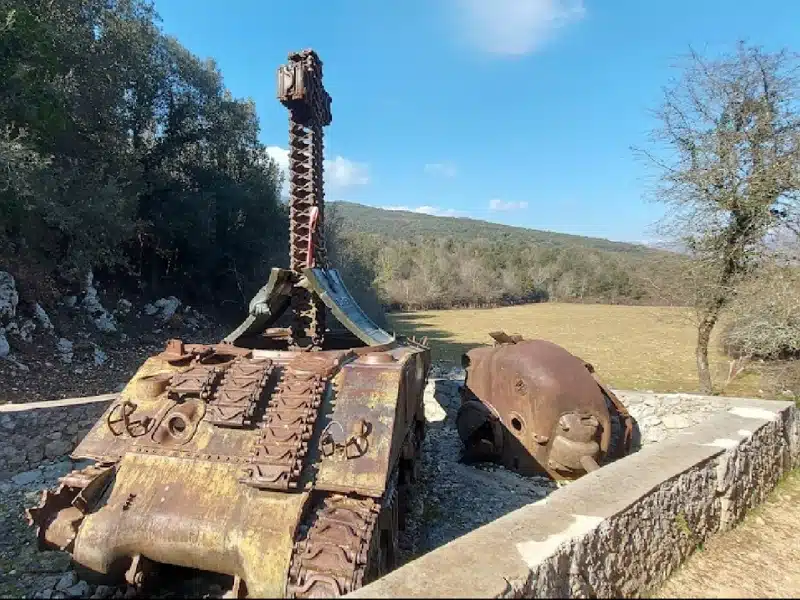
The Iron Cross
The third monument is the Iron Cross, erected on Hill 575 in June 1944 by the soldiers of the 5th Kresowa Infantry Division. The highest point of this hill was chosen to erect the monument so the memorial would be visible from the abbey and the Liri Valley, the site of the Fourth Battle of Monte Cassino, known as Operation Diadem.
To reach the peak, the Polish sappers built a serpentine road from the ruins of Masseria Albaneta, where a camp was set up for the crew carrying out the work in the following months. You can still walk up the remains of this track today.
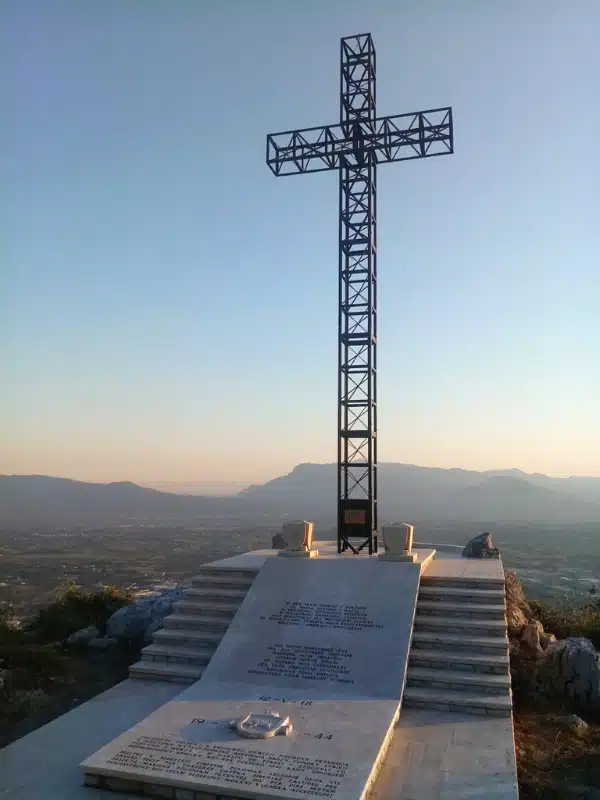
Conclusion
This was a day of two halves; the memorable visit to a place we had long wanted to see left us feeling uplifted and in awe of man’s ability to keep moving forward, to build again and again, in the midst of adversity.
This contrasted with such a moving and bewildering experience at the cemeteries. How on earth did WWII ever happen and how is it that we seem to have learned nothing from it?
Are you looking for more Italian travel inspiration? Check out these top posts…
Where is Hot in January in Europe? Top 36 Warmest Places
Autumn in Italy: Ultimate Travel Guide
Fall Travel in Europe: Weather, Wardrobe & Where to Go
Autumn in Europe: 28 Stunning Destinations for Fall
European Road Trip: Six Countries in 90 Days
25 Sun-Drenched Destinations for a Dreamy Italian Summer
Love it? Pin it!
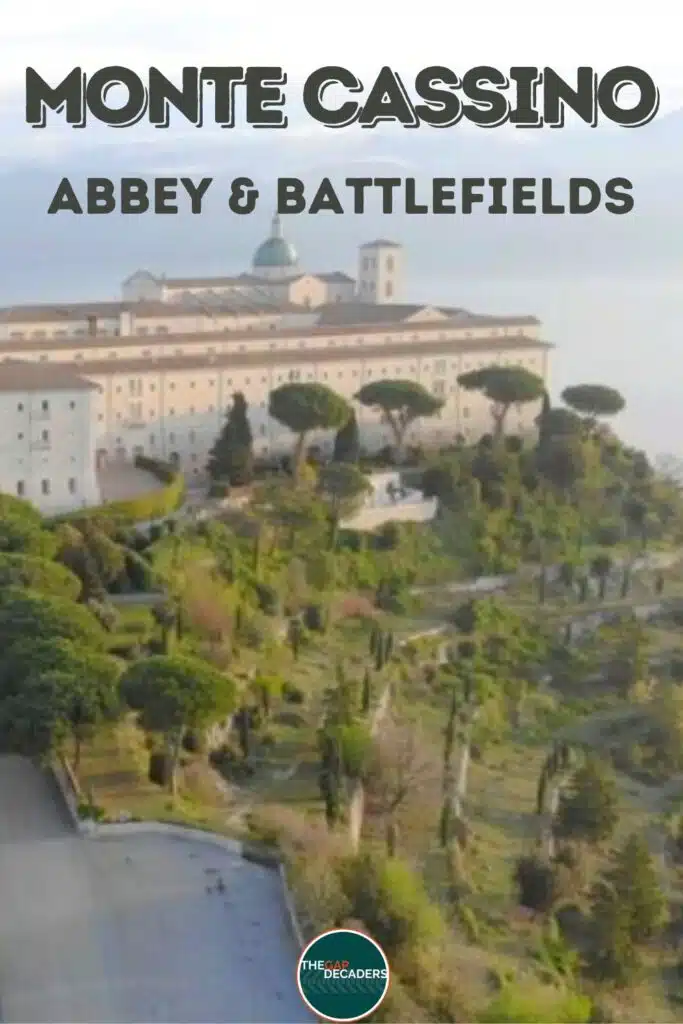
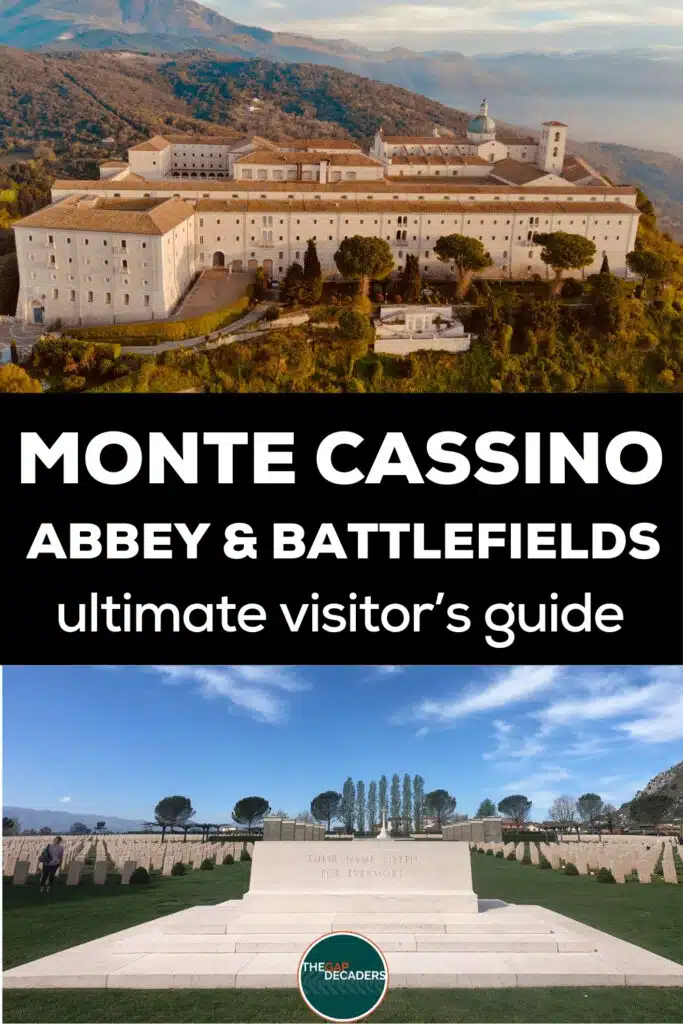


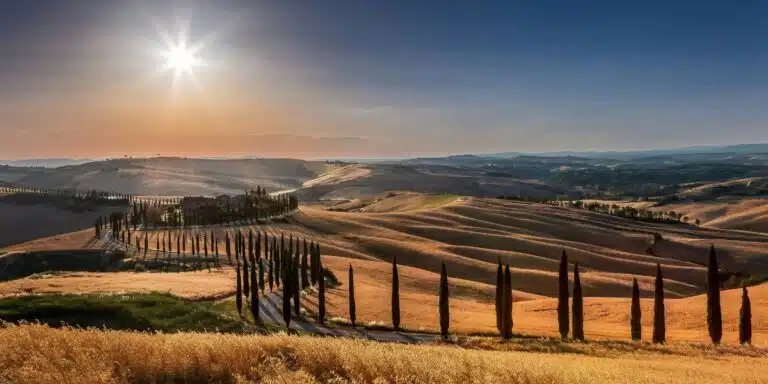
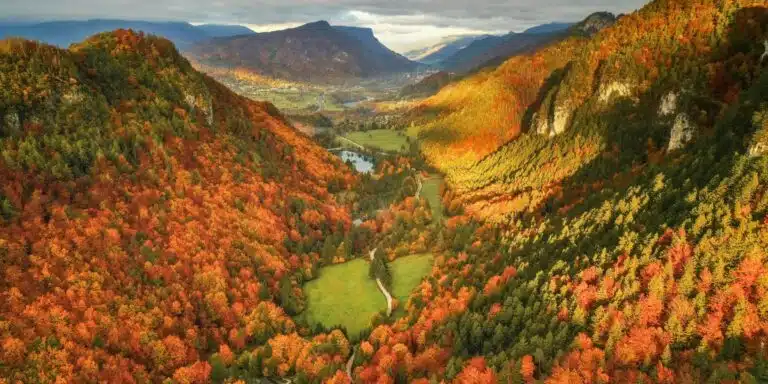
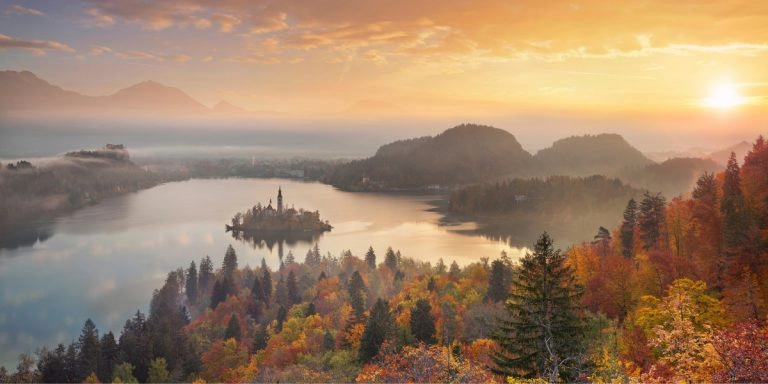
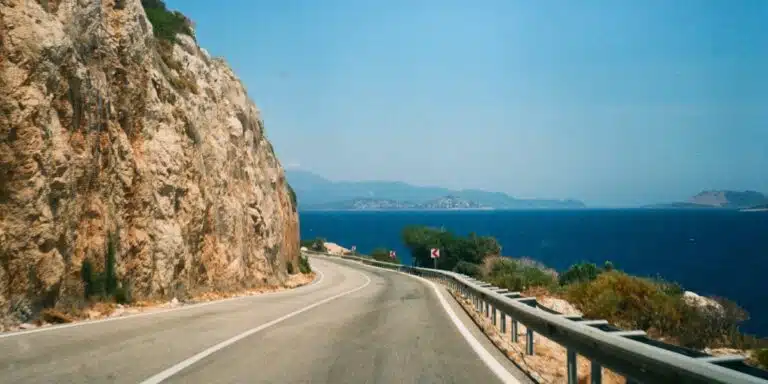
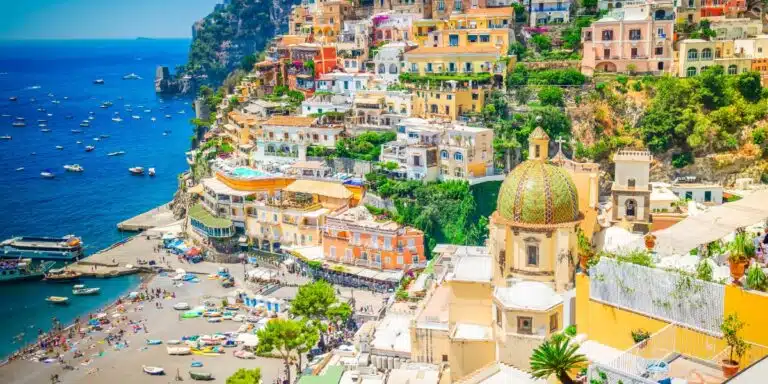
Hi Carolyn I think its totally appropriate for high school students – we should never forget the sacrifices made. Take the tour of the Abbey so you can fully understand the history. Hope that helps 🙂
As a parent, I appreciate this initiative! It’s vital for our kids to learn history firsthand. Looking forward to more details.
I was thinking of organizing a trip for my students to Monte Cassino, especially because of its rich history in WWII. Do you think it’s appropriate for high school students? Also, any tips on making the most of our visit to the Abbey? Would appreciate your advice. Thanks!